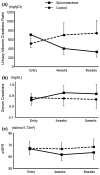Anti-albuminuric effects of spironolactone in patients with type 2 diabetic nephropathy: a multicenter, randomized clinical trial
- PMID: 25795029
- PMCID: PMC4577308
- DOI: 10.1007/s10157-015-1106-2
Anti-albuminuric effects of spironolactone in patients with type 2 diabetic nephropathy: a multicenter, randomized clinical trial
Abstract
Background: Several studies have demonstrated that spironolactone has an anti-albuminuric property in diabetic nephropathy. As an adverse event, spironolactone often induces the elevation of creatinine levels with hypotension and hyperkalemia. Therefore, we aimed to evaluate the efficacy and safety of spironolactone in Japanese patients with type 2 diabetes treated with either angiotensin-converting enzyme inhibitors or angiotensin receptor blockers.
Methods: Fifty-two Japanese patients with diabetic nephropathy and albuminuria (100 mg/gCr-2000 mg/gCr) treated with renin-angiotensin system (RAS) blockade were enrolled in a prospective, randomized, open-label study. The patients were subjected to add-on treatment with spironolactone 25 mg once daily and compared with matched controls for 8 weeks. The primary outcome was a reduction in the rate of albuminuria at 8 weeks compared with the baseline value. This study was registered with UMIN Clinical Trials Registry (000008016).
Results: Albuminuria was reduced by 33 % (95 % confidence interval: 22-54; P = 0.0002) at 8 weeks with spironolactone. In the spironolactone group, blood pressure tended to lower and the estimated glomerular filtration rate (eGFR) was significantly decreased compared to those in the control group. When adjusted by systolic blood pressure and eGFR, spironolactone treatment still showed a significant effect on albuminuria reduction in a linear mixed model (coefficient ± standard error; 514.4 ± 137.6 mg/gCr, P < 0.0005). No patient was excluded from the study because of hyperkalemia.
Conclusions: Spironolactone reduced albuminuria along with conventional RAS inhibitors in patients with diabetic nephropathy. Our study suggests that spironolactone exerts anti-albuminuric effects independent of systemic hemodynamic alterations.
Keywords: Albuminuria; Diabetic nephropathy; Randomized study; Spironolactone.
Conflict of interest statement
Figures
References
-
- International Diabetes Federation. IDF Diabetes Altas. 6. Brussels: 2013. pp. 29–49.
Publication types
MeSH terms
Substances
Associated data
Grants and funding
LinkOut - more resources
Full Text Sources
Other Literature Sources
Medical
Research Materials
Miscellaneous


